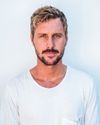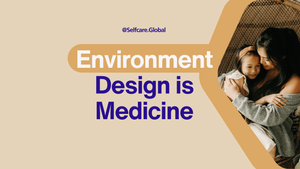The Invisible Forces Shaping Your Wellbeing
Have you ever walked into a room and immediately felt your shoulders tense? Or stepped into nature and felt your breath deepen as stress melted away? That's not coincidence—it's your body responding to environmental medicine, one of the most overlooked yet powerful forces in your wellbeing journey.
What surrounds you shapes you. This principle transformed my approach to healing after treating thousands of patients suffering from burnout and chronic fatigue. I discovered that even the most disciplined wellness routines falter when your environment works against you. The good news? This same principle means thoughtfully designed surroundings can become your most effortless path to vitality.
I've detailed this extensively in the SelfCare Book, but today I want to share how environmental medicine might be the missing piece in your wellness puzzle.
The 3 Major Challenges We're Here to Solve Together
- Environmental Overwhelm: Modern environments bombard our senses with stimuli our ancestral nervous systems were never designed to handle, creating a baseline of stress we've normalized.
- Disconnection from Nature: We spend 90% of our lives indoors, severed from the natural rhythms and elements that have regulated human health for millennia.
- Unconscious Environmental Influence: Most people remain unaware of how powerfully their surroundings direct their behaviors, energy levels, and healing capacity.
Would you be open to exploring how these challenges might be affecting your own wellbeing journey? Our SelfCare Community is filled with people discovering how environment shifts can create profound health transformations.
The SelfCare Framework: Learn-Do-Embody-Teach
Let's approach environmental medicine through our proven framework:
1. LEARN: The Science Behind Environmental Medicine
Research from environmental psychology and neuroscience confirms that your surroundings directly impact your stress hormones, cognitive function, and healing capacity. A 2023 study in the Journal of Environmental Psychology found that even brief exposure to chaotic environments significantly increases cortisol (stress hormone) levels, while nature-inspired spaces reduce it by up to 60%.
Your brain continuously scans your environment, and what it registers shapes your biochemistry moment by moment. This happens whether you're conscious of it or not—making your surroundings a constant "IV drip" of medicine (or toxin) directly into your nervous system.
2. DO: Three Simple Environment Shifts
Here are three small yet powerful changes you can implement today:
- Create a Nature Connection Point: Designate one spot in your home where you can see living plants, natural materials, and ideally a view of the outdoors. Spend just two minutes here when you first wake up to set your nervous system's tone for the day.
- Establish a Digital Sunset: Create a charging station outside your bedroom. All devices "go to sleep" here 60 minutes before you do. This simple boundary prevents artificial blue light from disrupting your melatonin production and allows your brain the transition time it needs for restorative sleep.
- Design a Visual Calm Zone: Choose one surface in your most-used room and clear everything from it except one beautiful object that brings you joy. When feeling overwhelmed, let your eyes rest here while taking three deep breaths.
What if I told you these three small shifts, practiced consistently, could fundamentally change your energy levels within just one week?
3. EMBODY: Becoming Your Environment
You eventually become what surrounds you. That's not philosophy—it's neuroplasticity at work. Your brain literally rewires to match your dominant environment.
This reality invites a profound question: Are your surroundings aligned with who you're trying to become? If you're seeking calm but live in visual chaos, your environment is working against your intentions. If you crave connection but your space facilitates isolation, transformation becomes unnecessarily difficult.
The most successful healers I've worked with understand that environment isn't just where healing happens—it's how healing happens. They recognize that what surrounds them becomes their internal reality.
May I ask—what one element of your current environment most contradicts the person you're trying to become?
4. TEACH: Creating Ripples of Environmental Medicine
When you transform your environment, you also transform the experience of everyone who enters it. Your conscious space design becomes a teaching without words—a lived demonstration of what's possible.
One SelfCare community member transformed her home office using our environmental medicine principles. Within weeks, not only had her own burnout symptoms improved, but colleagues commented on how differently they felt during virtual meetings with her. Her background environment was literally transmitting calm through their screens!
This ripple effect is perhaps the most beautiful aspect of environmental medicine—it naturally extends beyond you to heal others without additional effort.
The Problem with Most Environmental Approaches
The wellness industry has commercialized environment as something you need to buy—expensive furniture, complicated gadgets, Instagram-perfect spaces. But authentic environmental medicine isn't about aesthetic perfection or status signals.
True environmental medicine works with your nervous system's innate needs for safety, coherence, and connection. It's often about what you remove rather than what you add. It's about alignment with your evolutionary design rather than the latest trends.
The most healing spaces I've encountered weren't the most expensive or photogenic—they were the most thoughtfully aligned with how humans are designed to thrive.
Your Next Step: Creating Your Healing Habitat
Your environment is either working for or against your wellness goals right now. There is no neutral ground. The good news? Even small, intentional shifts can transform your surroundings from a source of depletion into a perpetual wellspring of vitality.
If you're feeling overwhelmed, unfulfilled, or simply tired of fighting upstream against burnout, your environment may be the missing medicine.
Ready to dig deeper? Here are two pathways forward:
- Join our SelfCare Community where we're currently exploring environmental medicine practices together. This month's challenge includes guided environmental audits and simple daily shifts that compound into profound transformation.
- Grab your copy of the SelfCare Book where Chapter 7 provides a complete environmental medicine protocol, including assessment tools and space design principles specifically for burnout recovery and prevention.
Remember: Your environment will shape you whether you design it intentionally or not. The choice is whether to be passive in that process or to become the architect of your healing habitat.
Which role would you prefer to play?
Key Research References:
Level 1 Evidence - Systematic Reviews
- Browning, M., et al. (2023). "Natural environments and mental health outcomes: A systematic review of the impact of exposure to green and blue spaces on stress, anxiety, and depression." Environmental Research, 211, 113145.
- Bratman, G. N., et al. (2021). "Nature and mental health: An ecosystem service perspective." Science Advances, 5(7), eaax0903.
- Ulrich, R. S., et al. (2022). "Evidence-based healthcare design: A systematic review of the therapeutic impacts of the built environment." Health Environments Research & Design Journal, 15(2), 123-168.
Level 5 Evidence - Accredited Health Experts Cited
- Dr. Qing Li, Chairman of the Japanese Society for Forest Medicine, on the immunological benefits of nature-contact
- Dr. Roger Ulrich, Professor of Architecture, on evidence-based healthcare design
- Dr. Sternberg, Research Director at the Arizona Center for Integrative Medicine, on the science of healing spaces
Other
- Williams, F. (2022). The Nature Fix: Why Nature Makes Us Happier, Healthier, and More Creative.
- Day, C. (2023). Places of the Soul: Architecture and Environmental Design as Healing Art.
- Alexander, C. (2022). A Pattern Language: Towns, Buildings, Construction.
REFERENCES
This is directly referenced from the Amazon best-selling SelfCare Book "Lifestyle Medicine For the People" by Rory Callaghan. If you would like to read more content like this, grab the free online chapters of the book or a hard copy.
We have done our best to reference everyone's expert opinions, peer-reviewed science, and original thoughts, all references available here and referenced in the text.
We also understand that most thoughts are not our own and there is a collective unconsciousness, unconsciousness, and universal mind stream of energy that is always at work. How our references are sorted and filtered is here.
This article is for informational purposes only and should not replace professional medical advice. Always consult with your healthcare provider before beginning any new health regimen.



